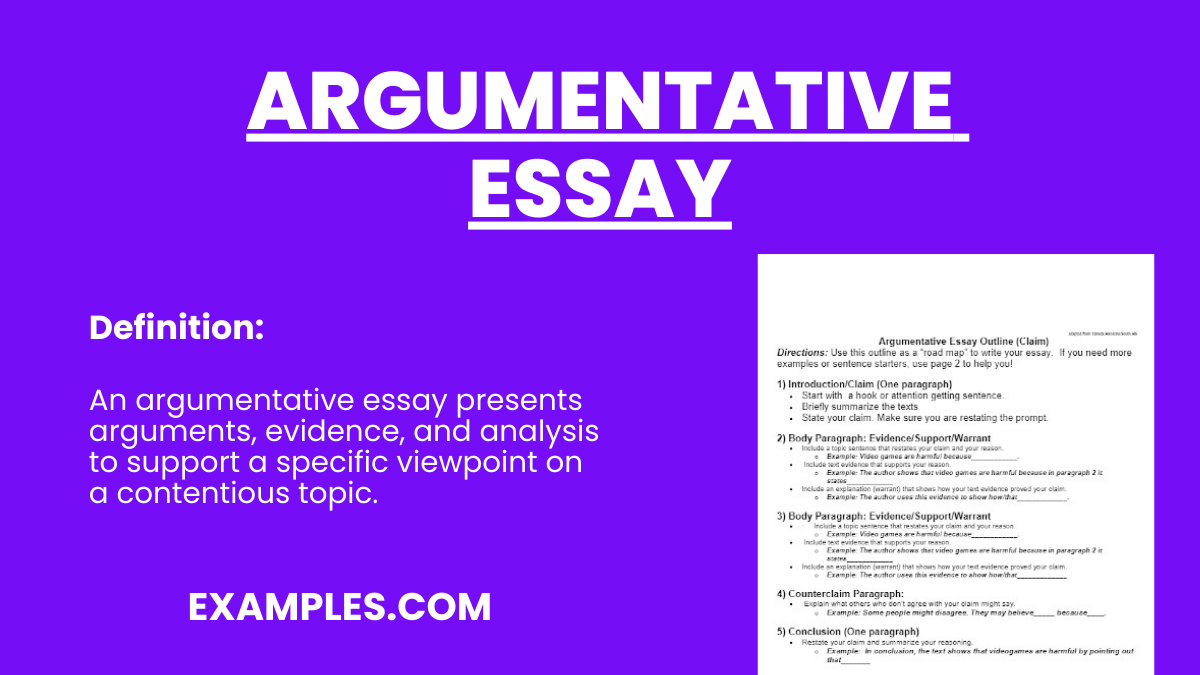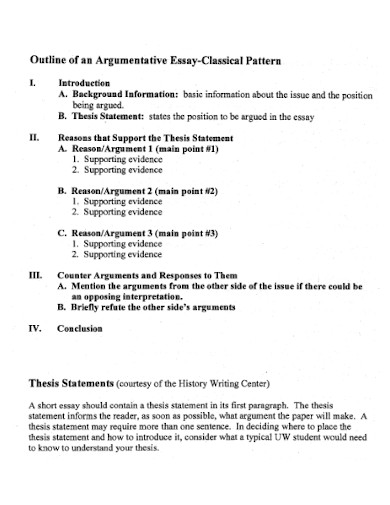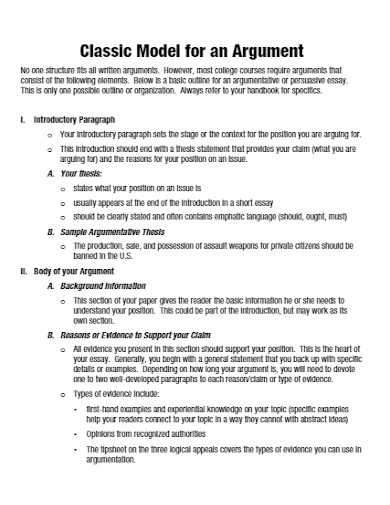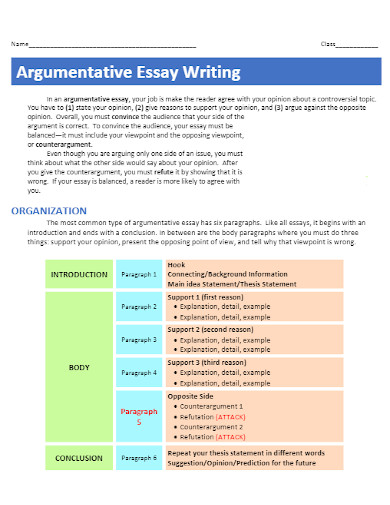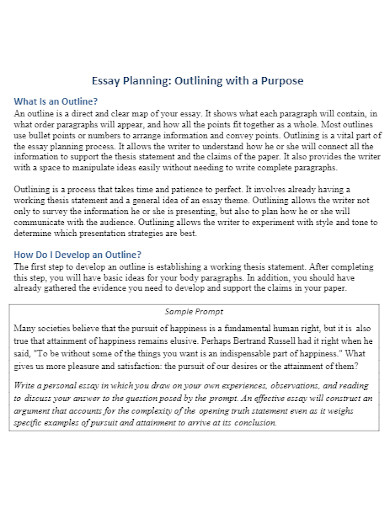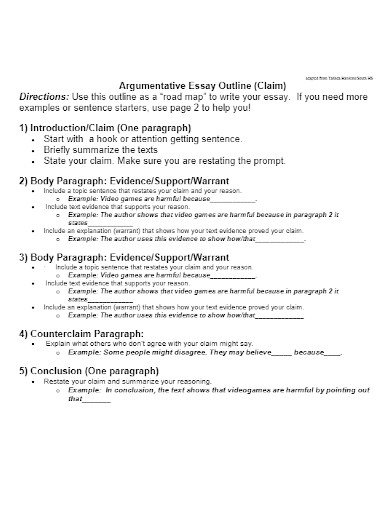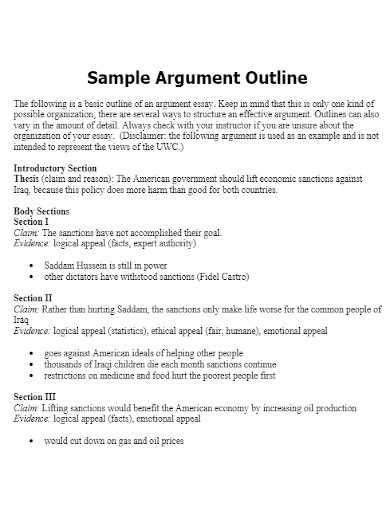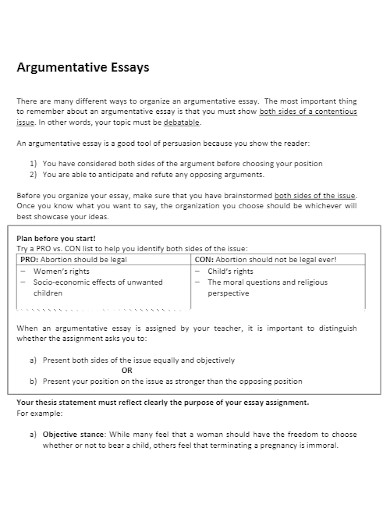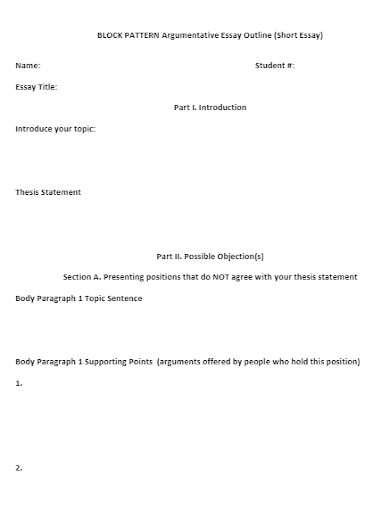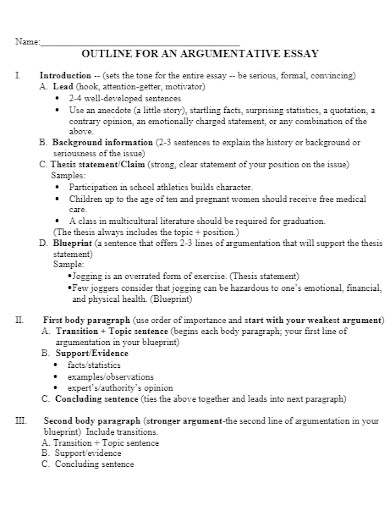25+ Argumentative Essay Examples to Download
It may be a little bit confusing writing an argumentative essay especially if it is for academic purposes. You should be loaded with facts or verified information to prove your point. Every argument needs an interesting topic for you to keep going with your entire work.
What is an Argumentative Essay?
An argumentative essay is a type of writing that presents a clear argument or position on a specific topic, supported by evidence and reasoning. The goal is to persuade the reader to understand and perhaps agree with the writer’s point of view. This essay typically includes a clear thesis statement, structured arguments, factual evidence, and a rebuttal to opposing viewpoints. The effectiveness of an argumentative essay lies in its ability to logically and coherently argue a point, while addressing and countering potential counterarguments.
Format/Structure of Argumentative Essay
An argumentative essay typically follows a clear and structured format to present and support an argument effectively. Here’s a breakdown of its essential components:
Introduction
Hook: Begin with a compelling statement, question, or fact to grab the reader’s attention.
Background Information: Provide context or background necessary to understand the topic or argument.
Thesis Statement: Clearly state your main argument or position on the topic. This should be precise, debatable, and convey the essence of your essay.
Body Paragraphs
Paragraph 1: Start with your strongest point or most convincing argument. Provide evidence (facts, statistics, studies, quotes) to support it.
Paragraph 2 and Beyond: Continue with subsequent arguments, each in its own paragraph. Ensure each point logically follows the previous one and adds weight to your overall argument.
Counterargument: Address a potential counterargument to your thesis, then refute it with logic, evidence, or both. This shows you’ve considered multiple viewpoints.
Conclusion
Restate Thesis: Reaffirm your thesis statement, but in different words.
Summarize Key Points: Briefly recap the main arguments you presented.
Call to Action or Final Thought: End with a thought-provoking statement, question, or call to action that encourages further thinking or action on the topic.
The Best Example of Argumentative Essay
Title: The Necessity of Environmental Conservation
Introduction The planet’s environmental health is a concern that affects all of humanity. Despite differing opinions, the need for environmental conservation is imperative for the following reasons: the survival of future generations, the balance of ecosystems, and the preservation of natural beauty.
Thesis Statement Environmental conservation is not just a moral duty but a necessary action for the survival and prosperity of our planet and future generations.
Body Paragraph 1: Survival of Future Generations Firstly, conserving the environment ensures the survival of future generations. Practices such as reducing carbon emissions and protecting natural habitats are crucial. For instance, reducing carbon emissions minimizes the greenhouse effect, directly impacting global warming and climate change.
Body Paragraph 2: Balance of Ecosystems Secondly, the conservation of the environment is essential for maintaining the balance of ecosystems. Human activities have led to the extinction of numerous species. Preserving natural habitats helps maintain biodiversity, which is vital for ecological balance, as emphasized in a study by the World Wildlife Fund.
Body Paragraph 3: Preservation of Natural Beauty Lastly, environmental conservation is important for preserving the natural beauty of the planet. Natural landscapes like forests, oceans, and mountains not only have aesthetic value but also contribute to human well-being, as suggested by numerous psychological studies.
Counterargument and Rebuttal Some argue that economic development should take precedence over environmental conservation. However, sustainable development models show that economic growth does not have to be at the environment’s expense. Green technologies and eco-friendly practices can lead to economic prosperity while preserving the environment.
Conclusion In conclusion, environmental conservation is a critical necessity. It ensures the survival of future generations, maintains ecological balance, and preserves the planet’s intrinsic beauty. The path towards sustainable development is not only possible but essential, aligning economic growth with environmental stewardship.
Argumentative Essay Topics with Samples
- The Impact of Social Media on Mental Health
- Should Vaccinations be Mandatory for Public Health?
- The Role of Artificial Intelligence in the Future of Work
- Climate Change: Myth or Reality?
- The Ethics of Genetic Editing in Humans
- Universal Basic Income: Solution to Economic Inequality?
- The Influence of Video Games on Youth Behavior
- Animal Testing: Necessary Evil or Outdated Practice?
- Is Remote Learning Effective in Education?
- The Debate on Gun Control Laws in the United States
- The Pros and Cons of Capital Punishment
- Privacy vs. Security in the Age of Surveillance
- The Cultural Impact of Globalization
- Vegetarianism and Veganism: Dietary Choice or Moral Obligation?
- The Rise of Cryptocurrencies: Future of Finance or Speculative Bubble?
Types of Argumentative Essay and How to Use Them?
Argumentative essays can be categorized into different types based on the approach and purpose of the argument. Understanding these types helps in crafting a more effective and targeted essay:
Classical (Aristotelian) Argumentative Essay
Rooted in the principles of Aristotle, this type of essay presents a clear, direct argument. It starts with an introduction of the topic, followed by the presentation of the writer’s position. The body provides logical reasoning and evidence supporting the argument, and it addresses and refutes counterarguments. The conclusion reinforces the thesis and sums up the argument.
Use this style for topics that can be argued logically and objectively. It’s effective in academic writing and debates where clear, rational arguments are needed.
Rogerian Argumentative Essay
This approach, based on the psychology of Carl Rogers, emphasizes understanding and finding common ground with the opposing viewpoint. Instead of outright refuting the opposing views, the writer acknowledges their validity and seeks a compromise or integrative solution.
Ideal for contentious or polarizing topics where bridging opposing views is important. It’s useful in emotionally charged debates where acknowledging different perspectives can lead to a more balanced conclusion.
Toulmin Argumentative Essay
Developed by Stephen Toulmin, this model focuses on constructing a clear and logical argument. It consists of six elements: claim, grounds (evidence), warrant (link between the claim and evidence), backing (support for the warrant), qualifier (limits of the claim), and rebuttal (addressing counterarguments).
Employ this method for complex arguments that require detailed analysis. It’s suitable for scientific or technical discussions where each aspect of the argument must be logically validated.
Persuasive Argumentative Essay
This type aims to persuade the audience to the writer’s point of view through emotional appeal and moral reasoning. It uses strong, emotive language and persuasive techniques like anecdotes, rhetorical questions, and sometimes, dramatic illustrations to sway the reader’s opinion.
Best for topics related to personal beliefs, values, or when the goal is to influence public opinion. Effective in speeches, advertising, and situations where emotional impact is crucial.
9+ Argumentative Essay Outline Examples
1. Argumentative Pattern Essay Outline
2. Argumentative Classical Model Essay Outline
3. Argumentative Essay Writing Outline
4. Argumentative Essay Planning Outline
5. Argumentative Essay Claim Outline
6. Sample Argumentative Essay Outline
7. Argumentative Essay of Debatable Outline
8. Argumentative Essay of Persuasive Outline
9. Editable Argumentative Essay Outline
10. Printable Argumentative Essay Outline
Elements of an Argumentative Essay
Introduction
this is the first part of your paper where you are going to talk about a certain issue in a way that you can grab the attention of your audience.
In your introduction, you should provide an opening line that will keep your readers stuck into your work until the end.
Thesis
this is the summary of your main idea supported by evidences
This is located at the end of your first paragraph. Every point you take in your argumentative essay must be related to the thesis statement that you wrote.
Evidence
these were also referred to as “claims”. This is all about the data and facts that you use to prove your point.
Justification
this justifies or explains your evidence. In your argumentative essay, you have to provide at least three paragraphs of supporting details that backs up your evidence.
Opposing argument
this is also called “refutation” that proves your opinion may not be true. Unlike any other essays like in a persuasive essay, an argumentative essay will let you see through the other side of the matter. Your work will appear stronger since it will be weighing two different stands whether which argument is more believable.
Conclusion
this is the summary of your entire argument including your main idea and the evidence. Always take note that you have to provide a concise conclusion.
You may want to check an example of a good argumentative essay below.
“The first objection last week came from the National Organization for Women and the New York Civil Liberties Union, both of which opposed the opening of TYWLS in the fall of 1996. The two groups continue to insist – as though it were 1896 and they were arguing Plessy V. Ferguson – that separate can never be equal. I appreciate NOW’s wariness of the Bush administration’s endorsement of single-sex public schools, since I am of the generation that still considers the label “feminist” to be a compliment – and many feminist still fear that any public acknowledgement of differences between the sexes will hinder their fight for equality.”
– Boys Here, Girls There: Sure, If Equality’s the Goal (by Karen Stabiner)
“We’ve become accustomed to a new way of being “alone together.” Technology-enabled, we are able to be with one another, and also elsewhere, connected to wherever we want to be. We want to customize our lives. We want to move in and out of where we are because the thing we value most is control over where we focus our attention. We have gotten used to the idea of being in a tribe of one, loyal to our own party.”
– The Flight from Conversation (by Sherry Turkle)
FAQs
What makes a good argumentative essay?
A good argumentative essay has focuses on facts rather than opinions and clear evidence that supports your claim.
How long is an argumentative essay?
It depends on how long your introduction, supporting facts and conclusion is.
Do I still need to provide a reference in my argumentative essay?
Every type of writing must have a reference page.
Argumentative essays must be supplied with strong arguments to convince the readers more about a debatable issue. It should contain elements such as introduction, thesis, evidence, justification, opposing argument and conclusion.


